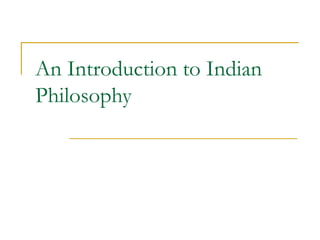
lecture1.ppt
- 1. An Introduction to Indian Philosophy
- 2. Texts and References S. Radhakrishnan and C. Moore, A Sourcebook in Indian Philosophy, Princeton University Press. S. Radhakrishnan, The Principal Upanishads, Oxford University Press. M.K. Gandhi, Collected Works, Vol. 1-100. Available online at http://www.gandhiserve.org/cwmg/cwmg.html S. Radhakrishnan, The Bhagavadgita, Oxford University Press. S. Dasgupta, A History of Indian Philosophy, Motilal Banarsidas. R. Puligandla, Fundamentals of Indian Philosophy, Abingdon Press. Journal of Indian Philosophy, Springer. M. Ram Murty, Indian Philosophy: An Introduction, Broadview Press.
- 3. Why study Indian philosophy? Philosophy literally means the love of knowledge or more precisely, the love of wisdom. In the past, many thinkers asked fundamental questions and probed the depths of their own mind for answers. The study of their writings is a valuable help in our journey to gain a greater understanding of ourselves and the universe we find ourselves in. As far back as 1500 B.C., we find in the hymns of the Rig Veda, a spirit of inquiry into the nature of things.
- 4. The Upanishads In the Mundaka Upanishad (1.1.3), we find the following verse: Kasmin nu bhagavo vijnate sarvam idam vijnatam bhavati iti. “What is that by knowing which everything is known?” In the Chandogya Upanishad (6.1.4), we find a variation: “Just as the knowledge of one slab of clay gives us knowledge of all clay, what is that by knowing which everything else becomes known.”
- 5. Why study philosophy? “Philosophy is to be studied, not for the sake of any definite answers to its questions since no definite answers can, as a rule, be known to be true, but rather for the sake of the questions themselves; because these questions enlarge our conception of what is possible, enrich our intellectual imagination and diminish the dogmatic assurance which closes the mind against speculation; but above all because, through the greatness of the universe which philosophy contemplates, the mind also is rendered great, and becomes capable of that union with the universe which constitutes its highest good.” - From Bertrand Russell’s, The Problems of Philosophy. Bertrand Russell (1872-1970)
- 6. The method of asking questions This method of inquiry is usually called the Socratic method, after Socrates. Some questions may not have answers. Yet, this is our only method to gain understanding.
- 7. Godel’s Theorem In any axiomatic system, there will be propositions which can neither be proved or disproved in that system. Kurt Godel (1906-1978)
- 8. The Katha Upanishad Is it possible to arrive at the essence of knowledge? Sraddha This refers to a deep conviction that there are “truths” to be grasped and we have the ability to do so. “One of the most incomprehensible things about the universe is that it is comprehensible.”
- 9. The method of analogy In the Mundaka Upanishad, we find: “As a spider sends forth and draws in its thread, as herbs grow on the earth, as the hair grown on the human head and body, so also from the Imperishable arises this universe.”
- 10. Outline of Indian Philosophy Vedic Period (2500 B.C. – 600 B.C.) Epic Period (600 B.C. – 200 A.D.) Sutra Period (200 A.D. – 600 A.D.) Scholarly Period (600 A.D. – 1700 A.D.) The Modern Period (1700 – present)
- 11. Sanskrit This is a highly structured language with precise rules of grammar. It is phonetic. The roots of many European languages, including English can be traced back to Sanskrit. Linguists infer the existence of Proto-Indo European (PIE) language from which Sanskrit is derived going as far back as 3500 BCE.
- 12. The Four Vedas Rig Veda Yajur Veda Sama Veda Atharva Veda Each Veda is divided into four parts: Mantras, Brahmanas, Aranyakas, and Upanishads.
- 13. Mantra This word is derived from two Sanskrit words: Manas which refers to the mind Trayate which means to protect. Thus mantra is that which protects the mind. The word trayate also refers to that which reveals, or releases or delivers. It also refers to the power of reflection of the human mind. Manush in Sanskrit means “human being’’ The English word “man” is derived from this word. The word mananam refers to reflection.
- 14. Brahman This word is derived from the Sanskrit root word brih which means vast and expansive. Thus, Brahman refers to that which is vast and expansive. The word brahmin, refers to a priest, or more accurately, to a scholar.
- 15. Aranyakas and Upanishads These are the philosophical portions of the Vedas. Veda is derived from the root word vid which means “to know”. Aranya means “forest” and aranyaka means “forest writing” Upanishad is a combination of three Sanskrit words: upa, ni, shad whose translation approximates: “near”, “below” and “sit”
- 16. Monism versus Non-dualism Dualism refers to any theory that states that there are two irreducible components to the subject under investigation. Monism is the assertion that there is only one. Non-dualism is the assertion that there are not two.
- 17. The Epic Period The Ramayana of Valmiki The Mahabharata of Vyasa
- 18. The Bhagavadgita
- 19. Sutra Period Six systems of Philosophy Nyaya Vaisesika Samkhya Yoga Purva Mimasa Uttara Mimamsa or Vedanta
- 20. Scholarly Period (600A.D.-1700 A.D.) Three great philosophers stand out during this period. They are Shankara, Ramanuja, and Madhva.
- 21. The Modern Period (1700-present) The writings of the modern period are mainly in English, and so easier to read. Vivekananda (1863-1902) Aurobindo (1872-1950) M.K. Gandhi (1869-1948) J. Krishnamurti (1895-1986) S. Radhakrishnan (1888-1975) R. Tagore (1861-1941)